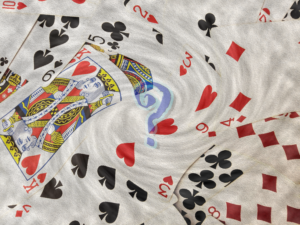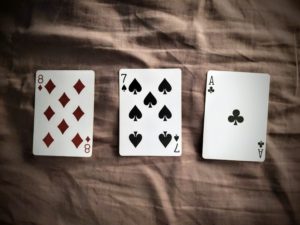Cartomancy is the practice of using cards to perform divination or fortune-telling. Not too long after playing cards came to Europe in the fourteenth century, people were using them to predict the future.
This makes sense, once you realize that “randomness” is more or less a modern concept.

If you look at the history of mathematics, and the development of mathematical tools, the study of probability came to the party pretty late. It’s not until the sixteenth century that we get the concept of “odds” in the form of a ratio–describing something as having a “1-in-3” chance, for instance. Today, this sort of thing is taught in elementary school.
Prior to this development, randomness was seen less mathematically or mechanistically, and more as an unpredictable, pernicious force which held one’s fate in its hands. It was the wild and wavering will of the gods, or “fortune” itself, which caused your dice, cards, or life to come up as they did. And the hand of fate was fickle.
Today, randomness still plays a key role in not just cartomancy, but in many forms of divination. Geomancy, one of the favorite divinatory methods of medieval Europe, uses a series of randomly-drawn dots as its basis. Another example can be found in the I Ching, a form of divination developed in China between two and three thousand years ago. It uses stalks or “lots” chosen at random.
This idea of using “random” events to perform divination is called “sortilege,” and it’s actually pretty clever if you think about it. Want to know where fortune is taking you? Cast some lots or throw some cards and see how they land. It’s rather like determining which direction the wind is blowing by sprinkling some dust before you and watching how it moves.
In a very real sense, we’re hoping the cards will tell us what the “winds of change” are up to.


Now when most people think of cartomancy, they almost immediately land on the tarot. Again, this makes sense. In almost every movie, and in nine out of ten real-world situations, when someone whips out a deck of cards to tell a fortune, that deck is a tarot deck. It’s more or less ingrained in our cultural consciousness at this point. It should be noted, however, that not only were fortune tellers using regular playing cards first, many fortune tellers today do the same.
So let’s say we give it a shot!
The simplest form of divination using playing cards requires us to only ask yes-or-no questions. We think of a question, shuffle and cut the cards, then deal out three of them face-up. If there are more red cards on the table than black ones, the answer is “yes.” More black than red? The answer is “no.” As simple as this sounds, it’s a tried and true method used by countless cartomancers. That said, we can elaborate on it a bit, in the interests of Science.
Here’s a fairly simple and straight-forward procedure for performing basic, yes-or-no divination using playing cards. You’ll of course need a standard deck of fifty-two cards (jokers and promo cards removed). You might also want to get a notebook and pencil to keep track of your questions, answers, and results. I say this because without keeping some kind of record of your “experiments,” it’ll be pretty hard to determine if there’s actually anything unusual going on. Of course, you don’t have to use paper and pencil if you’d prefer taking notes on a computer or your phone. Whatever floats your boat.
Simple Cartomancy
- Grab your cards, notebook, and pencil, then find a relatively quiet place where you can sit without being disturbed. This could be your kitchen table, your computer desk, whatever. You don’t need some kind of fancy divination space. You just want to be able to sit comfortably, deal out cards, and not have people rushing about and making a lot of noise around you.
- Take a minute or two to relax, shuffle the cards, and think about your question.
- Your question should be specific and it should be answerable with a definite yes or a no. Don’t ask a question like “Should I apply for the job?” What does the word “should” really mean? A better question might be: “Will I get this job if I apply for it?” Or: “Will I be happier working for FILL-IN-THE-BLANK company?”
- Try to ask questions which you know you will learn the answer to in the relatively near future. For instance, if you applied for a new job, sooner or later you’re going to know whether or not they hire you. Similarly, if you’re thinking about asking someone out on a date, your question could be: “Will SO-AND-SO go out with me?” You’ll know what the actual answer is once you ask them.
- Avoid “unknowable” or long-term questions. “Is there a God?” is a question you might get an answer to someday, but it’s not likely to be something you’ll be able to reliably verify anytime soon. In the same vein, “Will I ever get married?” is a very open-ended question. Instead, maybe try: “Will I get married this year?”
- Once you have a question firmly in mind, and you’ve thoroughly shuffled the cards, cut the deck and deal out three cards face-up.
- More red cards than black ones? Take that as a “yes.” More black than red? Take that as a “no.” We’re deliberately keeping this simple. While skilled cartomancers do associate specific meanings with specific cards, this basic method is frequently used and totally fine.
- Record the date and time of this sitting in your notebook, along with the question you asked and the answer you received. You might also want to note down which specific cards turned up, but it’s not strictly necessary.
- If you want to ask another question during this sitting, go ahead. Just repeat the steps above from the beginning, making sure to shuffle all the cards back into the deck before you ask a new question.
If you run through this process for a few different sittings, you’ll end up with several questions and answers in your notebook. Obviously, the next step is to pay attention and see how events actually turn out. When you finally learn the “real” answer to a question, write it down in your notebook next to the answer the cards gave you. This way, you can keep track of your “hits” and “misses.”
I really, really love experiments like this. They’re incredibly easy to perform, and it’s incredibly easy to keep track of your data. The whole process takes no more than ten minutes, and it basically costs nothing if you already have a deck of cards kicking around and some method of taking notes. If you do this experiment even just once or twice a week, you’ll have a pile of data in a few months which you can look back on to see if this stuff “works” for you.
And when you do look back on that data, there are a couple of questions worth asking beyond the obvious. (And by “obvious,” I mean whether or not the answers you’re getting from the cards are accurate more than half of the time. If there’s nothing more to all of this than “random chance,” the cards’ answers should be divided about 50-50 between right and wrong.)
First, is the accuracy of the cards somehow tied to how quickly the question gets resolved? For example, let’s say you have several questions which you’ll learn the actual answer to within a week, and several others which you’ll only learn the answer to in a month or more. Do the cards more accurately predict the answer to the first group of questions?
Second, do you find the cards becoming more accurate over time? That is, let’s say you do the experiment ten times during the first month and only get an accurate answer for five of those tests. If you do the experiment ten times the following month, do you get more accurate answers? What about the third month? The fourth?
These are just some of the questions you can ask yourself when looking back over your notes. I’m sure you’ll think of many others.
Have fun! And may fortune be ever in your favor.
